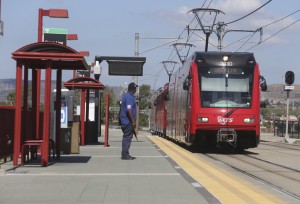Voice of San Diego ran an excellent piece assessing San Diego’s Gillespie Field trolley stop, ranked in our recent study as the worst station neighborhood in all of California. As reporter Maya Srikrishnan reports:
Nearly 3,500 people live in the half-mile area surrounding that station, and about 4 percent of residents and 6 percent of workers take transit. Seven percent of the nearby residents don’t have their own vehicle.
To put those numbers in context, the stations in downtown, urban neighborhoods are surrounded by far more people, and a much larger share of them rely on transit. The half-mile area around the 12th and Imperial Station has a population of 9,529 (five times Gillespie Field), and about 31 percent of residents and 14 percent of workers use the trolley (seven times and three times more than Gillespie). About 26 percent of households in the half-mile radius don’t own vehicles, four times more than near Gillespie. The numbers are similar at the other high-ranking San Diego station at Civic Center.
I spent an hour last Wednesday morning – from 9 to 10 a.m. at the Gillespie station. Only one person got on a train. I had missed the commuter crowd, but the station’s parking lot wasn’t even half full. Our photographer spent 40 minutes taking pictures of the station on Tuesday and only two people boarded.
The next day, as people went home from work from nearby warehouses and manufacturing and other industrial companies around 5 p.m., the trolley station was a bit more crowded. But even during rush hour, a maximum of 10 people boarded any given train.
“It’s a good stop,” said Brittney Scott, who commutes from Lemon Grove on the trolley every day to her job at the House of Magnets warehouse – about a 10-minute walk from Gillespie Field Station. “Nice view, no one here.”
“This station is cleaner,” Scott said. “But it’s because no one uses it.”
It was always my hope that the study would motivate more attention on under-performing rail station neighborhoods. And the good news is that the East County Economic Development Council in San Diego may now try to implement a March 2015 plan to spur development in the area. According to the article, on Tuesday, the Council’s airport committee will review an agreement with a consultant to further develop plans for the area and seek partnerships with developers to implement the plan.
They cite the need for financing as one potential barrier, so this is a good area for state policy to help, perhaps through infrastructure finance districts or cap-and-trade funding. But it’s good to see local willingness to improve the area. That’s the crucial first step.
One thought on “The Worst Rail Station Neighborhood In California”
-
Pingback: San Diego Media Are Focusing On Need For Better Transit-Oriented Development | Ethan Elkind
Leave a Reply
You must be logged in to post a comment.



